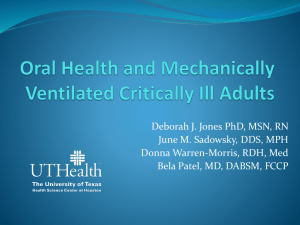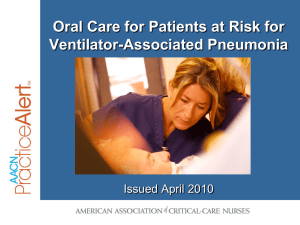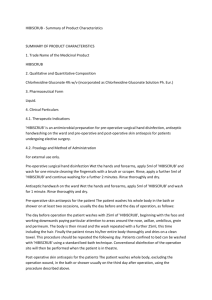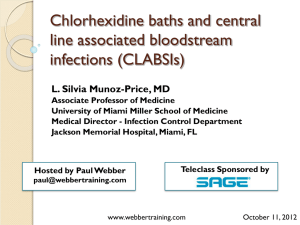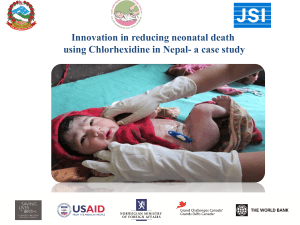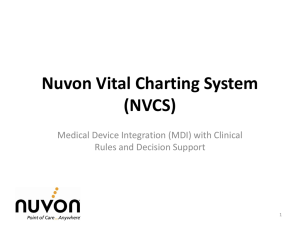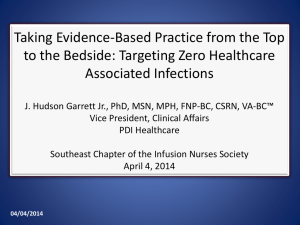The Effect of Chlorhexidine on the Rate of Ventilator Associated
advertisement
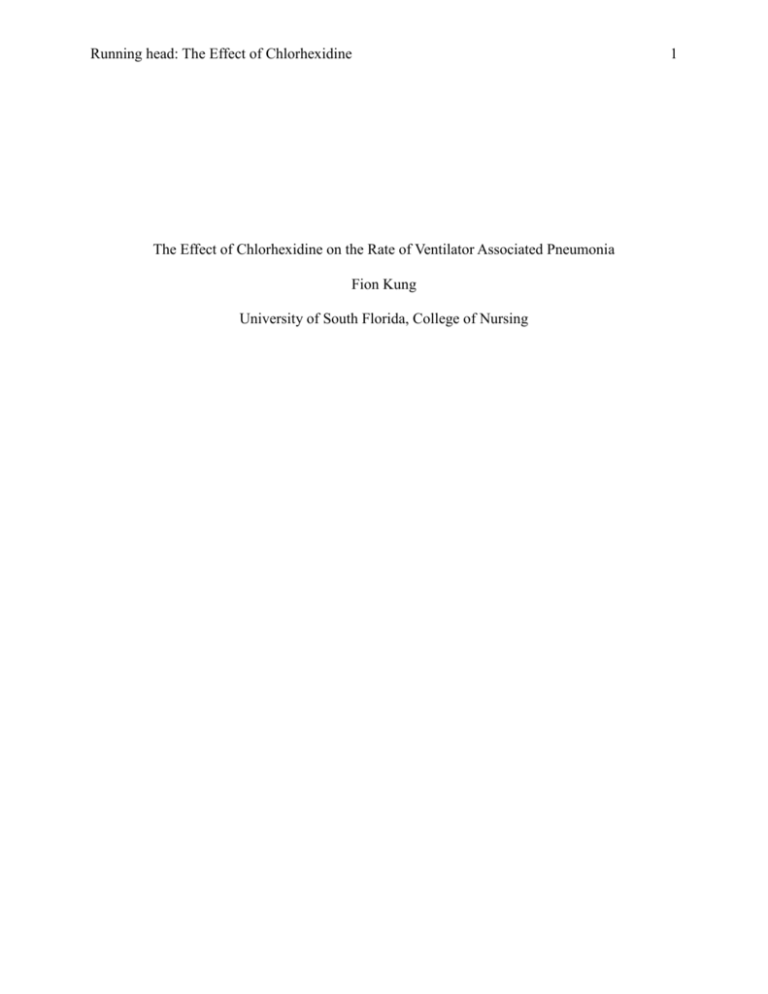
Running head: The Effect of Chlorhexidine The Effect of Chlorhexidine on the Rate of Ventilator Associated Pneumonia Fion Kung University of South Florida, College of Nursing 1 THE EFFECT OF CHLORHEXIDINE 2 Abstract Clinical problem: Ventilator-associated pneumonia (VAP) is the second most common health care-associated infection in the United States. Ventilator-associated pneumonia is associated with increases in death rates, length of stay, and health care costs. There were about 250,000 cases of healthcare-associated pneumonia developed in United States hospitals and 36,000 of the cases were associated with deaths in 2002. Objective: To determine if there is adequate evidence to reduce the rate of ventilator-associated pneumonia by using 0.12% chlorhexidine compared to sterile water in ICU patients. Data sources: Search engines including PubMed and CINAHL were used to locate three applicable current research studies using the key words: oral care, ventilator-associated pneumonia, chlorhexidine, periodontal disease, sterile water, and intensive care unit. Evidence based practice was also retrieved by Sedwick et al., (2012). Result: The results indicate 0.12% chlorhexidine reduce the chance of developing ventilatorassociated pneumonia. Conclusion: Through a synthesis of selected literature, it has been concluded that 0.12% chlorhexidine with oral care significantly reduces the chance of developing ventilator-associated pneumonia in mechanically ventilated patients. THE EFFECT OF CHLORHEXIDINE 3 The Effect of Chlorhexidine on the Rate of Ventilator Associated Pneumonia Ventilator-associated pneumonia (VAP) is the second most common health careassociated infection in the United States and is a leading cause of morbidity and mortality in intensive care units (ICU) (Sedwick, Lance, Reeder and Nardi, 2012). Furthermore, it is also associated with increase in the length of hospital stay and health care costs. VAP is an infectious complication that allows bacteria into the lung, which it can cause some lung or immune system problems. VAP usually occurs in mechanically ventilated patients. According to Centers for Disease Control and Prevention (2013), this is an important clinical issue that needs to be evaluated due to the incidence of about 250,000 healthcare-associated pneumonia cases developed in United States hospitals, while 36,000 of the cases were associated with deaths in 2002. In addition, there was more than 3,525 cases of VAP reported with an estimate of 0.0-4.9 per 1,000 ventilator days from the National Healthcare Safety Network (NHSN) facilities in 2011 (CDC, 2013). Furthermore, among patients treated with mechanical ventilation, there were 46% mortality rate for those who developed VAP and 32% mortality rate for those who did not developed VAP (Sedwick et al., 2012). Current research aims to discover the effectiveness of oral care by using 0.12% chlorhexidine for mechanically ventilated patients to prevent ventilator-associated pneumonia. In order to evaluate the use of 0.12% chlorhexidine for mechanically ventilated patients a PICOT question was formulated. In patients admitted to the intensive care unit, how does daily use of chlorhexidine compared to sterile water reduce ventilator-associated pneumonia during the hospitalized stay? This paper will focus on the review of applicable current research articles and evidence based projects for implementation of findings. THE EFFECT OF CHLORHEXIDINE 4 Literature Search and Review Articles were found regarding the effect of chlorhexidine on the rate of ventilatorassociated pneumonia (Table 1). Search engines including PubMed and CINAHL were used to locate applicable current researchable information using the key words: oral care, chlorhexdine, intensive care unit, periodontal disease, sterile water, ventilator-associated pneumonia. Chlorhexidine Oral Swab Özçaka et al. (2012) completed a randomized, double-blind, controlled trial to examine how effective 0.2% chlorhexidine gluconate (CHX) with oral swabbing is for reducing the chances of developing ventilator-associated pneumonia in ICU patients. Sixty-one patients who were mechanically ventilated and expected to remain ventilated for at least 48 hours after admission were selected for inclusion to the study (Özçaka et al., 2012). There were twenty-nine patients in the intervention group who received an oral swab of 30 mL of 0. 2% chlorhexidine gluconate four times per day. On the other hand, the control group had thirty-two patients that only used an oral swab with normal saline. In the study, clinical periodontal measurements and lower- respiratory-tract specimens were used for further analysis after detecting the early stages of VAP (Özçaka et al., 2012). The authors found that ventilator-associated pneumonia was significantly higher in control group (68.8%) than chlorhexidine group (41.4%); p=0.03 (Özçaka et al., 2012). The strength of the study is that they used the randomized, double blind, controlled study method to divide patients into different groups. Lack of knowledge about the patients' background and disease can therefore avoid any bias. However, the weakness of the study is a small size of population with only sixty-one patients. Due to the small population size, the result might not be as accurate as it would be with a larger population. Therefore, additional studies with larger samples are needed to validity the findings. THE EFFECT OF CHLORHEXIDINE 5 Chlorhexidine versus Toothbrushing Munro, Grap, Jones, McClish and Sessler (2009) conducted research to test if two oral care interventions, toothbrushing and 0.12% solution chlorhexidine, would decrease the risk for VAP during the first week of intubation for mechanically ventilated patients. The population of the study was critically ill adults in the ICU who were intubated within 24 hours of admission. The study was completed by conducting a randomized control trial where a total of 547 patients were randomly assigned to one of four groups (Munro et al., 2009). The groups were divided randomly into 0.12% solution chlorhexidine oral swab twice daily (n=119), toothbrushing thrice daily (n=113), combination of toothbrushing and chlorhexidine (n=116) and control group (n=123). The data were collected from the day of admission to day 7 of intubation or until extubation (Munro et al., 2009). However, due to early extubation, the smaller sample size on days 5 through 7 did not allow conclusions regarding the effect of the study. Therefore, the authors used data up to day 3 for analysis of the results of the study. The results showed that there was no significant differences for developing VAP between chlorhexidine and toothbrushing group compared to the chlorhexidine group alone. However, the study showed 0.12% chlorhexidine with oral swab twice daily significantly decreased the incidence of VAP by day 3 (Munro et al., 2009). One of the strengths in the study is that they also elevated toothbrushing to assess alternative methods to reduce the VAP rate. However, the improvement in the study is there were 547 patients in the study, and by the third day there were only 249 patients in the study remained intubated. Early Application of Chlorhexidine The final study examined how effective an early single dose of 0.12% chlorhexidine decreases the chance of developing VAP on patients who are intubated within twelve hours after THE EFFECT OF CHLORHEXIDINE 6 admission to the hospital (Grap et al., 2011). A total of 145 patients were randomly assigned to the intervention or control group. Seventy-one patients in the intervention group used a single application of 5 mL of 0.12% chlorhexidine solution swab for the oral cavity. On the other hand, there were 74 patients in the control group who only had standardized oral care without 0.12% chlorhexidine swab. The authors used the clinical pulmonary infection score to evaluate the effect of the intervention at 48 and 72 hours after patients were intubated. Grap et al. (2011) showed that the VAP development rate was significantly higher in the patients only receiving standard oral care at 55.6%, while the infection rate was only 33.3% for those who received a single dose of chlorhexidine after intubation. The strength of the study is that they used a randomized controlled clinical trial which meant that patients were randomly assigned to groups without any bias. On the other hand, the weakness of the article is that the population is too small; therefore, additional studies with larger samples are needed. Evidence Based Project Sedwick, Lance, Reeder and Nardi, (2012) discussed specific evidence based research to develop a ventilator bundle as well as practices for critical care nurses to decrease the VAP rate. The authors were attempting to determine evidence based projects to be used regarding mechanically ventilated patients to decrease the risk of ventilator-associated pneumonia. The evidence based projects stated that in order to decrease the incidence of VAP, nurses should provide multiple interventions to mechanically ventilated patients including elevating the head of bed, daily sedation vacation, peptic ulcer disease prophylaxis, deep vein thrombosis prophylaxis, and oral care with chlorhexidine (Sedwick et al., 2012). Synthesis THE EFFECT OF CHLORHEXIDINE 7 Research has shown that there is a significant reduction of developing ventilatorassociated pneumonia when 0.12% chlorhexidine is used for mechanically ventilated patients in ICU. The research shows that promoting oral care by using 0.12% chlorhexidine can reduce bacterial growth. Implementation of good oral care has positive effects for mechanically ventilated patients including the following: improving patient's outcomes, decreasing patients' length of stays in the hospital, and reducing health care costs. While in other country a high concentration of 0.2% chlorhexidine is used, because of the United States of Food and Drug Administration regulating, a 0.12% chlorhexidine is recommended. Future research needs to continue to evaluate how 0.12% chlorhexidine prevented ventilator-associated pneumonia with more controlled trials and larger population groups. Clinical Recommendations Florida Hospital is one of the largest non-profit health care providers with twenty-two campuses that are located in different communities throughout Florida. Florida Hospital of Tampa and affiliates have proven their importance in the community. The hospital has several opportunities to educate the staff and raise awareness of the importance of oral care by using 0.12% chlorhexidine, especially with the mechanically ventilated patients. In order to utilize the evidence based research and guidelines appropriately, the unit educator in the ICU need to implement evidence based oral care by educating the nurses to use 0.12% chlorhexidine for mechanically ventilated patients. The charge nurses also ensure the staff and faculties are implementing good oral care by using 0.12% chlorhexidine to mechanically ventilated patients. In addition, the nurses need to develop strategies to put evidence-based practices together into the daily care for mechanically ventilated patients. In relation to the stated PICOT question, since using 0.12% chlorhexidine for ICU mechanically ventilated patients has been shown to reduce THE EFFECT OF CHLORHEXIDINE 8 the incidence of ventilator-associated pneumonia, healthcare workers should begin to implement current practices to prevent complications. Therefore, recommendations are to provide oral care by using 0.12% chlorhexidine for the mechanically ventilated patients. THE EFFECT OF CHLORHEXIDINE 9 References Centers for Disease Control and Prevention. (2013). NHSN Protocol Clarifications. Retrieved October 19, 2013, from http://www.cdc.gov/nhsn/pdfs/pscmanual/6pscvapcurrent.pdf Grap, M., Munro, C., Hamilton, V., Elswick, R., Sessler, C., & Ward, K. (2011). Early, single chlorhexidine application reduces ventilator-associated pneumonia in trauma patients. Heart & Lung: The Journal Of Critical Care, 40(5), e115-e122. doi:10.1016/j.hrtlng.2011.01.006 Munro, C.L., Grap, M.J., Jones, D.J., McClish, D.K., & Sessler, C.N. (2009). Chlorhexidine, toothbrushing, and preventing ventilator-associated pneumonia in critically ill adults. American Journal of Critical Care, 18(5), 428-37; doi: 10.4037/ajcc2009792 Özçaka, Ö., Başoğlu, Ö. K., Buduneli, N., Taşbakan, M. S., Bacakoğlu, F. & Kinane, D. F. (2012). Chlorhexidine decreases the risk of ventilator-associated pneumonia in intensive care unit patients: A randomized clinical trial. Journal of Periodontal Research, 47, 584– 592. doi: 10.1111/j.1600-0765.2012.01470.x Sedwick, M.B., Lance-Smith, M., Reeder, S.J., & Nardi, J. (2012). Using evidence-based practice to prevent ventilator-associated pneumonia. Critical Care Nurse, 32(4), 41-51. doi: 10.4037/ccn2012964 THE EFFECT OF CHLORHEXIDINE 10 Table 1 Summary of studies reviewed Reference Özçaka, Ö., Başoğlu, Ö. K., Buduneli, N., Taşbakan, M. S., Bacakoğlu, F. & Kinane, D. F. (2012). Chlorhexidine decreases the risk of ventilatorassociated pneumonia in intensive care unit patients: A randomized clinical trial. Journal of Periodontal Research, 47, 584– 592. doi: 10.1111/j.16000765.2012.01470.x Munro CL, Grap MJ, Jones DJ, McClish DK, Sessler CN. (2009) Chlorhexidine, toothbrushing, and preventing ventilatorassociated pneumonia in critically ill adults. American Journal of Critical Care, 18(5):428-37; quiz 438. doi: 10.4037/ajcc20097 92. Aims Design and Measures To examine how Randomized, effective 0.2% double-blind, chlorhexidine clinical control gluconate with oral study. swabbing is reducing the chances of developing ventilatorassociated pneumonia in ICU patients. Sample To determine the use of mechanical toothburshing, 0.12% chlorhexidine, and combination of toothburshing and chlorhexidine effect to develop VAP in critically ill patients. 547 patients in ICU were intubated within 24 hours. 119 patients on chlorhexidine group, 113 patients in toothbrushing group, 116 patients on combination of chlorhexidine and toothbrushing group, and 123 patients in the control group. Randomized, controlled clinical trial with 2x2 factorial designs. Clinical pulmonary infection score was used to determine how many patients develop VAP. 61 dentate patients scheduled for invasive mechanical ventilation. 29 patients in the intervention group. 32 patients in the control group. Outcomes / statistics The percentage of VAP rate in control group was 68.8%, and chlorhexidine group was 41.4%; p= 0.03. Chlorhexidine significantly reduced the incidence of pneumonia on day 3 (CPIS > 6) (p=0.006). THE EFFECT OF CHLORHEXIDINE Grap, M., Munro, C., Hamilton, V., Elswick, R., Sessler, C., & Ward, K. (2011). Early, single chlorhexidine application reduces ventilatorassociated pneumonia in trauma patients. Heart & Lung: The Journal Of Critical Care, 40(5), e115e122.doi:10.1016/j. hrtlng.2011.01.006 To examine how effective of single 0.12% chlorhexidine decrease chance of develop VAP on patients who intubed within 12 hours in the hospital. 11 Randomized, controlled clinical trial. Clinical pulmonary infection score was used to evaluated on the study admission and at 48 and 72 hours after intubation. 145 patients who were required endotracheal intubation. 71 patients in the intervention and 74 patients in the control group. The percentage of VAP rate in control group was 55.6%, and intervention group was 33.3%. The CPIS from admission to 48 hours (p=0.020) and admission to 72 hours (p= 0.027)
